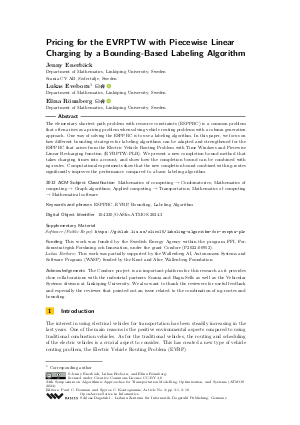Pricing for the EVRPTW with Piecewise Linear Charging by a Bounding-Based Labeling Algorithm
Authors
Jenny Enerbäck,
Lukas Eveborn  ,
Elina Rönnberg
,
Elina Rönnberg 
-
Part of:
Volume:
24th Symposium on Algorithmic Approaches for Transportation Modelling, Optimization, and Systems (ATMOS 2024)
Part of: Series: Open Access Series in Informatics (OASIcs)
Part of: Conference: Symposium on Algorithmic Approaches for Transportation Modelling, Optimization, and Systems (ATMOS) - License:
 Creative Commons Attribution 4.0 International license
Creative Commons Attribution 4.0 International license
- Publication Date: 2024-10-07
File

PDF
OASIcs.ATMOS.2024.3.pdf
- Filesize: 0.74 MB
- 18 pages
Document Identifiers
Subject Classification
ACM Subject Classification
- Mathematics of computing → Combinatorics
- Mathematics of computing → Graph algorithms
- Applied computing → Transportation
- Mathematics of computing → Mathematical software
Keywords
- ESPPRC
- EVRP
- Bounding
- Labeling Algorithm
Metrics
- Access Statistics
-
Total Accesses (updated on a weekly basis)
0PDF Downloads0Metadata Views
Abstract
The elementary shortest path problem with resource constraints (ESPPRC) is a common problem that often arises as a pricing problem when solving vehicle routing problems with a column generation approach. One way of solving the ESPPRC is to use a labeling algorithm. In this paper, we focus on how different bounding strategies for labeling algorithms can be adapted and strengthened for the ESPPRC that arises from the Electric Vehicle Routing Problem with Time Windows and Piecewise Linear Recharging function (EVRPTW-PLR). We present a new completion bound method that takes charging times into account, and show how the completion bound can be combined with ng-routes. Computational experiments show that the new completion bound combined with ng-routes significantly improves the performance compared to a basic labeling algorithm.
Cite As Get BibTex
Jenny Enerbäck, Lukas Eveborn, and Elina Rönnberg. Pricing for the EVRPTW with Piecewise Linear Charging by a Bounding-Based Labeling Algorithm. In 24th Symposium on Algorithmic Approaches for Transportation Modelling, Optimization, and Systems (ATMOS 2024). Open Access Series in Informatics (OASIcs), Volume 123, pp. 3:1-3:18, Schloss Dagstuhl – Leibniz-Zentrum für Informatik (2024)
https://doi.org/10.4230/OASIcs.ATMOS.2024.3
BibTex
@InProceedings{enerback_et_al:OASIcs.ATMOS.2024.3,
author = {Enerb\"{a}ck, Jenny and Eveborn, Lukas and R\"{o}nnberg, Elina},
title = {{Pricing for the EVRPTW with Piecewise Linear Charging by a Bounding-Based Labeling Algorithm}},
booktitle = {24th Symposium on Algorithmic Approaches for Transportation Modelling, Optimization, and Systems (ATMOS 2024)},
pages = {3:1--3:18},
series = {Open Access Series in Informatics (OASIcs)},
ISBN = {978-3-95977-350-8},
ISSN = {2190-6807},
year = {2024},
volume = {123},
editor = {Bouman, Paul C. and Kontogiannis, Spyros C.},
publisher = {Schloss Dagstuhl -- Leibniz-Zentrum f{\"u}r Informatik},
address = {Dagstuhl, Germany},
URL = {https://drops.dagstuhl.de/entities/document/10.4230/OASIcs.ATMOS.2024.3},
URN = {urn:nbn:de:0030-drops-211911},
doi = {10.4230/OASIcs.ATMOS.2024.3},
annote = {Keywords: ESPPRC, EVRP, Bounding, Labeling Algorithm}
}
Author Details
- Department of Mathematics, Linköping University, Sweden
- Scania CV AB, Södertälje, Sweden
Funding
This work was funded by the Swedish Energy Agency within the program FFI, Fordonsstrategisk Forskning och Innovation, under the grant Condore (P2022-00952).
- Eveborn, Lukas: This work was partially supported by the Wallenberg AI, Autonomous Systems and Software Program (WASP) funded by the Knut and Alice Wallenberg Foundation.
Acknowledgements
The Condore project is an important platform for this research as it provides close collaborations with the industrial partners Scania and Ragn-Sells as well as the Vehicular Systems division at Linköping University. We also want to thank the reviewers for useful feedback and especially the reviewer that pointed out an issue related to the combination of ng-routes and bounding.
Supplementary Materials
- Software (Public Repo) https://gitlab.liu.se/eliro15/labeling-algorithm-for-evrptw-plr
References
- Roberto Baldacci, Aristide Mingozzi, and Roberto Roberti. New route relaxation and pricing strategies for the vehicle routing problem. Oper. Res., 59(5):1269-1283, 2011. URL: https://doi.org/10.1287/OPRE.1110.0975.
- Moritz Baum, Julian Dibbelt, Andreas Gemsa, Dorothea Wagner, and Tobias Zündorf. Shortest feasible paths with charging stops for battery electric vehicles. CoRR, abs/1910.09812, 2019. URL: https://arxiv.org/abs/1910.09812.
- Natashia Boland, John Dethridge, and Irina Dumitrescu. Accelerated label setting algorithms for the elementary resource constrained shortest path problem. Oper. Res. Lett., 34(1):58-68, 2006. URL: https://doi.org/10.1016/J.ORL.2004.11.011.
- Claudio Contardo and Rafael Martinelli. A new exact algorithm for the multi-depot vehicle routing problem under capacity and route length constraints. Discret. Optim., 12:129-146, 2014. URL: https://doi.org/10.1016/J.DISOPT.2014.03.001.
- Guy Desaulniers, Fausto Errico, Stefan Irnich, and Michael Schneider. Exact algorithms for electric vehicle-routing problems with time windows. Oper. Res., 64(6):1388-1405, 2016. URL: https://doi.org/10.1287/OPRE.2016.1535.
- Ece Naz Duman, Duygu Tas, and Bülent Çatay. Branch-and-price-and-cut methods for the electric vehicle routing problem with time windows. Int. J. Prod. Res., 60(17):5332-5353, 2022. URL: https://doi.org/10.1080/00207543.2021.1955995.
- Jenny Enerbäck. A labelling algorithm for the resource constrained elementary shortest path problem. Master Thesis, Linköping University, 2024. URL: urn:nbn:se:liu:diva-205286.
- Dominique Feillet, Pierre Dejax, Michel Gendreau, and Cyrille Gueguen. An exact algorithm for the elementary shortest path problem with resource constraints: Application to some vehicle routing problems. Networks, 44(3):216-229, 2004. URL: https://doi.org/10.1002/NET.20033.
-
Stefan Irnich and Guy Desaulniers. Shortest path problems with resource constraints. In Column generation, pages 33-65. Springer, 2005.

- Edward Lam, Guy Desaulniers, and Peter J. Stuckey. Branch-and-cut-and-price for the electric vehicle routing problem with time windows, piecewise-linear recharging and capacitated recharging stations. Comput. Oper. Res., 145:105870, 2022. URL: https://doi.org/10.1016/J.COR.2022.105870.
- Alejandro Montoya, Christelle Guéret, Jorge E. Mendoza, and Juan G. Villegas. The electric vehicle routing problem with nonlinear charging function. Transportation Research Part B: Methodological, 103:87-110, 2017. URL: https://doi.org/10.1016/j.trb.2017.02.004.
- Diego Pecin, Artur Alves Pessoa, Marcus Poggi, and Eduardo Uchoa. Improved branch-cut-and-price for capacitated vehicle routing. Math. Program. Comput., 9(1):61-100, 2017. URL: https://doi.org/10.1007/S12532-016-0108-8.
-
Rafael Martinelli Pinto. Exact algorithms for arc and node routing problems. These de doctorat, Pontifcia Universidade Católica do Rio de Janeiro, 2012.

- Giovanni Righini and Matteo Salani. Symmetry helps: Bounded bi-directional dynamic programming for the elementary shortest path problem with resource constraints. Discret. Optim., 3(3):255-273, 2006. URL: https://doi.org/10.1016/J.DISOPT.2006.05.007.
- Michael Schneider, Andreas Stenger, and Dominik Goeke. The electric vehicle-routing problem with time windows and recharging stations. Transp. Sci., 48(4):500-520, 2014. URL: https://doi.org/10.1287/TRSC.2013.0490.
- Marius M. Solomon. Algorithms for the vehicle routing and scheduling problems with time window constraints. Oper. Res., 35(2):254-265, 1987. URL: https://doi.org/10.1287/OPRE.35.2.254.
